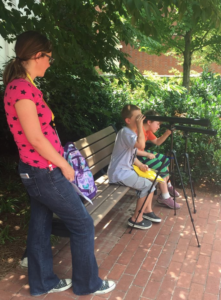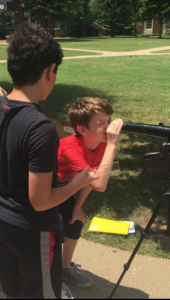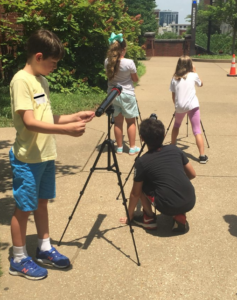Summer SAVY 2018: Session 3, Day 3 – Observational Astronomy (Rising 3rd/4th)
Today in Observational Astronomy we worked with tools and data analysis.
We started the day talking about things they we did yesterday , about interesting things they learned, and favorite events yesterday. Most students were very enthusiastic about the stories in the planetarium (as expected 🙂 ).
Then we worked with the planisphere and worked on how to find rise times, how those are associated with dates and particular stars and constellations. In order to see more action and to show off one of my favorite computer programs, we examined Stellarium – students were pretty fascinated with it so expect to hear about this one! There’s both a desktop program and an app!
After our break and collecting more Sun data with our quadrants and compasses, we started looking at our Galileoscope data that we collected on Monday. After aggregating the data we realized that something was a bit imprecise with our data, so I decided to redo the data collection. Students actually were very pleased to be able to use the Galileoscopes again and were much more rigorous with their data collection and were much more successful and less frustrated today than they were on Monday.
After lunch we collected solar data with compasses and quadrants again. Then we started analyzing our new Galileoscope data. We started looking for patterns and relationships then we started doing predictions given the data that we had. Of course we had to test our predictions so that was interesting!
When we were analyzing our Galileoscope data, students made a simple bar graph and so I decided it was time for us to start doing scatter plots. Students started graphing their data that they’ve been collecting from our solar observing (using the quadrant and compasse) and I was very impressed with the knowledge of some and the quick uptake by others! Students are starting to see some patterns and then in future days we will be analyzing further data that’s collected from internet databases and also ourselves – we’ll determine some patterns relating altitude, azimuth, and time I’m sure.
Dr. G
More Work with Telescopes


